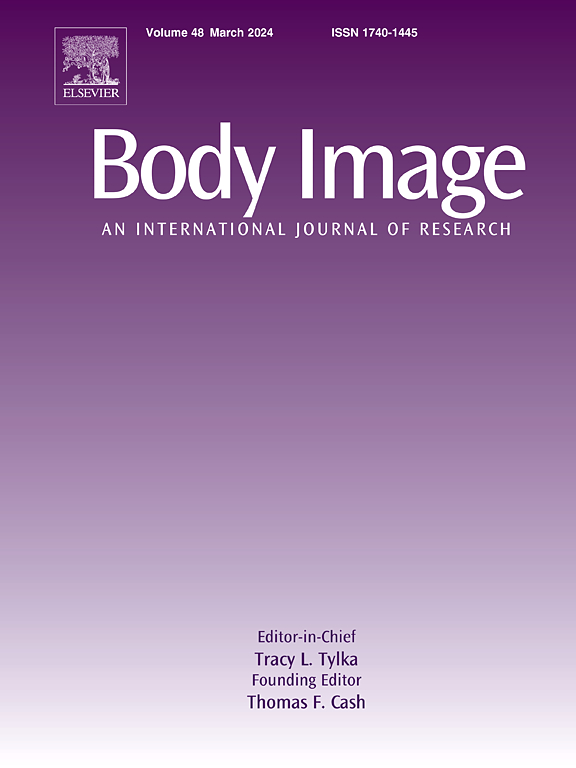Exploring longitudinal associations between thinness- and muscularity-oriented eating and body image disturbances in Chinese adult women and men
IF 5.4
1区 心理学
Q1 PSYCHIATRY
引用次数: 0
Abstract
Individuals striving for socially promoted thin and muscular body ideals are at risk of developing thinness- and muscularity-oriented eating and body image disturbances. Thinness and muscularity are not mutually exclusive but rather interconnected components of contemporary body ideals. However, prior studies have largely examined these associations within each category (e.g., body fat dissatisfaction with thinness-oriented disordered eating or muscularity dissatisfaction with muscularity-oriented disordered eating), which neglects potential cross-category relationships. The present study, which addressed this research gap, explored these cross-category longitudinal associations at baseline (T1) and 6 months later (T2). Employing gender-specific cross-lagged models, we analyzed data from an online sample of 799 Chinese women and men. We examined four cross-category reciprocal relationships: (1) body fat dissatisfaction with muscularity dissatisfaction, (2) body fat dissatisfaction with muscularity-oriented disordered eating, (3) thinness-oriented disordered eating with muscularity dissatisfaction, and (4) thinness-oriented disordered eating with muscularity-oriented disordered eating. Results revealed gender-specific cross-category associations. Particularly, positive, bidirectional associations were observed among women between thinness- and muscularity-oriented eating and body image disturbances. Among men, the associations were unidirectional, with muscularity-oriented eating and body image disturbances at T1 predicting greater thinness-oriented disordered eating at T2, but not vice versa. These findings advanced existing knowledge of the cross-category relationships between thinness- and muscularity-oriented eating and body image disturbances, with important implications for gender-specific interventions in non-clinical adults. For women, programs should address the reciprocal reinforcement between thinness- and muscularity-oriented eating and body image disturbances, while for men, targeting muscularity-oriented disturbances may help reduce subsequent thinness-oriented disordered eating.
探讨中国成年女性和男性以瘦和肌肉为导向的饮食与身体形象障碍之间的纵向联系
追求社会所推崇的苗条和肌肉的理想身材的人有可能患上以苗条和肌肉为导向的饮食和身体形象紊乱。苗条和肌肉发达并不是相互排斥的,而是当代身体理想中相互联系的组成部分。然而,先前的研究主要是在每个类别内检查这些关联(例如,以瘦为导向的饮食失调的体脂不满或以肌肉为导向的饮食失调的肌肉不满),而忽略了潜在的跨类别关系。本研究弥补了这一研究空白,探讨了基线(T1)和6个月后(T2)的这些跨类别纵向关联。采用性别交叉滞后模型,我们分析了来自799名中国女性和男性的在线样本数据。我们研究了四种跨类别的相互关系:(1)体脂不满意与肌肉不满意,(2)体脂不满意与肌肉导向饮食失调,(3)以瘦为导向的饮食失调与肌肉导向的饮食失调,(4)以瘦为导向的饮食失调与肌肉导向的饮食失调。结果显示了性别特异性的跨类别关联。特别是,在女性中,以瘦和肌肉为导向的饮食与身体形象障碍之间存在积极的双向关联。在男性中,这种关联是单向的,T1时以肌肉为导向的饮食和身体形象障碍预示着T2时更大的以瘦为导向的饮食失调,反之则不然。这些发现推进了现有的以瘦和肌肉为导向的饮食与身体形象障碍之间的跨类别关系的知识,对非临床成人的性别干预具有重要意义。对于女性来说,计划应该解决以瘦和肌肉为导向的饮食和身体形象障碍之间的相互强化,而对于男性来说,针对以肌肉为导向的障碍可能有助于减少随后的以瘦为导向的饮食失调。
本文章由计算机程序翻译,如有差异,请以英文原文为准。
求助全文
约1分钟内获得全文
求助全文
来源期刊

Body Image
Multiple-
CiteScore
8.70
自引率
28.80%
发文量
174
期刊介绍:
Body Image is an international, peer-reviewed journal that publishes high-quality, scientific articles on body image and human physical appearance. Body Image is a multi-faceted concept that refers to persons perceptions and attitudes about their own body, particularly but not exclusively its appearance. The journal invites contributions from a broad range of disciplines-psychological science, other social and behavioral sciences, and medical and health sciences. The journal publishes original research articles, brief research reports, theoretical and review papers, and science-based practitioner reports of interest. Dissertation abstracts are also published online, and the journal gives an annual award for the best doctoral dissertation in this field.
 求助内容:
求助内容: 应助结果提醒方式:
应助结果提醒方式:


